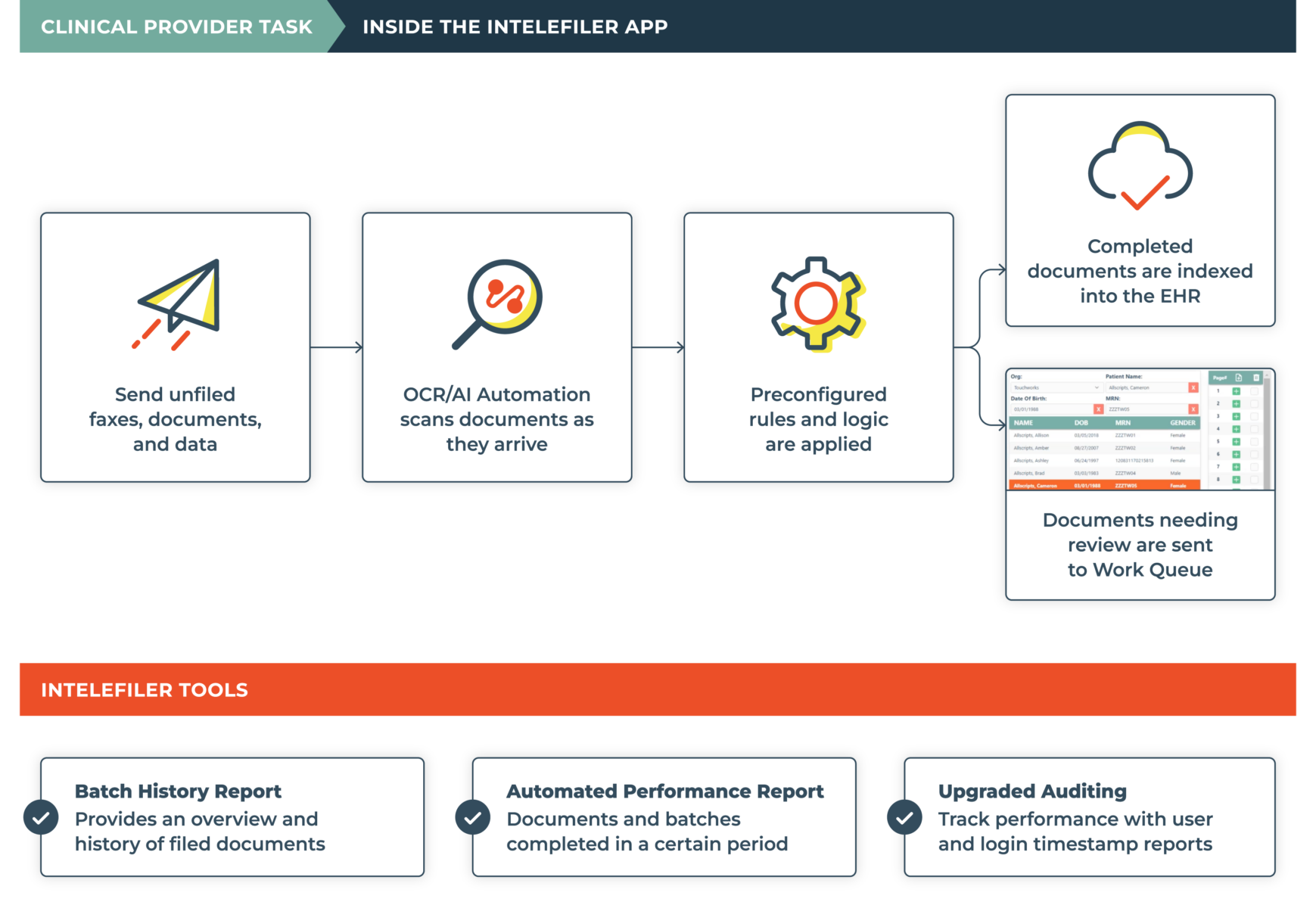Introduction
Healthcare organizations are under constant pressure to balance rising costs, complex compliance requirements, and the unrelenting growth of clinical and operational documents. Traditional manual processes such as fax handling, medical record indexing, and chart management, are no longer sustainable. They consume valuable staff hours, create backlogs, and contribute to errors, burnout, and turnover.
Emerging technologies now make it possible to reimagine document management as a driver of organizational performance rather than a burden. By applying the latest automation, artificial intelligence (AI), optical character recognition (OCR), and machine learning technology with advanced database management, healthcare leaders can transform document workflows into streamlined, accurate, and scalable processes.
This white paper explores how leveraging these technologies enables measurable breakthroughs in productivity, compliance, and workforce resilience, while freeing staff to focus on higher-value tasks and patient care.
Roadblocks to Document Workflow Transformation
Workforce Realities
Staffing challenges across healthcare amplify existing administrative inefficiencies and put additional strain on already thin margins. Document management and indexing roles are particularly vulnerable because of their repetitive, detail-oriented nature:
- Retirement of long-tenured leaders creates gaps in institutional knowledge, leaving teams without experienced oversight.
- New hires often leave within weeks when faced with the monotonous, repetitive work of indexing, leading to rapid attrition.
- High turnover and churn force managers into an endless cycle of recruitment and retraining, draining resources and stalling productivity.
- Burnout among remaining staff further reduces efficiency and increases the risk of errors in patient records.
Automation technology and staff outsourcing to a trusted partner alleviates these pressures by shifting repetitive tasks away from internal teams. This not only reduces turnover risk and eliminates training cycles but also ensures a consistent, professional level of throughput, often at a lower cost than maintaining internal staff. In many cases, outsourcing also improves quality and accuracy, enabling clinical and administrative staff to focus on higher-value work that directly supports patient care and organizational goals.
Establish best Practices and Metrics
Stage 1
Moving from broad claims of “efficiency” to demonstrable, measurable performance requires the consistent use of metrics. Without benchmarks, leaders have little visibility into whether document management processes are effective or sustainable.
Keena recommends organizations track the following:
- Documents/pages acquired vs. filed (weekly) – ensuring incoming volumes are consistently managed without backlogs.
- Per page throughput – recognizing that multi-page documents are often processed more quickly than single-page files, provides a fair measure of productivity.
- Outstanding documents/pages awaiting filing – monitoring backlogs in real time to prevent downstream impacts on clinical care and compliance.
- Average search time reporting for unfiled documents – highlighting bottlenecks and improving visibility, ensuring staff can quickly locate and complete filing tasks before they disrupt workflows or delay patient care.
Best Practice: To maintain productivity and reduce turnover risk, indexing roles should average no more than 25 hours per week. Beyond this threshold, accuracy and engagement drop significantly, leading to burnout, higher error rates and turnover.
By adopting these best practices and metrics, organizations gain visibility into performance, identify bottlenecks early, and establish a foundation for continuous improvement in document management.
Pro-Tip
Consider using an outside consulting organization with experience and expertise that can leverage the latest tools and technology to efficiently implement Stage-1 at your organization.
Consulting Services: Enhancing Technology with Workflow Effectiveness
Consider hiring a consulting organization that can bridge the gap by pairing technology expertise with workflow analysis to deliver measurable gains. The right partner should understand automation, AI, and data management, and bring expertise in HIPAA and patient safety best practices. This ensures every improvement in document workflow strengthens compliance, protects sensitive health information, and reduces the risk of errors that can impact patient care.
The best consultants can help organizations achieve measurable gains:
- Identify hidden inefficiencies that drain productivity and increase costs.
- Maximize existing system investments, ensuring organizations leverage all available functionality.
- Increase throughput with fewer resources, enabling staff to work smarter, not harder.
- Develop sustainable best practices, aligning document workflows with organizational goals.
Combining advanced technology with deep consulting expertise, delivers not just incremental improvements but true operational transformation, turning document management from a persistent burden into a measurable competitive advantage.
This combination of technology + consulting delivers true operational transformation.
Leverage OCR and AI Automation to Transform Workflow
Stage 2
Once best practices and metrics are in place, the next step is to reduce reliance on manual workflows. The latest enhancements in automation technologies now make it possible to route and file documents with speed and accuracy that human processes alone cannot achieve. By leveraging OCR, AI, and intelligent workflow design, organizations can ensure the right documents land in the right patient record—quickly, accurately, and with minimal human intervention.
Look for these key features and benefits when evaluating automated indexing systems:
Keena recommends organizations track the following:
- Leverages OCR and AI technology to automate filing and routing
- Decreases backlogs to improve efficiency and reduce labor costs
- Enables org-specific indexing rules and profiles to reduce processing time
- Leverages templates for high-volume document types
- Allows for batch splitting for faster filing
- Reduces duplicate and manual handling errors
- Designed with reporting, auditing and performance reports needs in mind
- Automates 70–80% of an organization’s document handling, while reserving expert human intervention for the final 20%
Used appropriately, these process automation capabilities create a foundation for workforce stability and prepare organizations to advance toward a workflow strategy that combines document management with a broader data management strategy highlighted in Stage-3.
Pro-Tip
As an example of this approach, Keena developed the InteleFiler application to serve as the central engine for document workflow automation. It streamlines fax and document intake, applying advanced OCR and AI technology to route files directly into the correct patient record with consistency and precision, while reducing the need for manual intervention.

Aligning Document Management with Your Data Strategy
Stage 3
Transitioning to Stage-3 means expanding the view beyond indexing and workflow automation. The real power lies in treating document management as a core component of your overall data management strategy. Documents are not just files to be stored, they are vital clinical, financial, and operational assets. When managed holistically, they support compliance, improve accessibility, and strengthen performance across the enterprise.
Complementary Keena Data Management Solutions to Consider:
- Keena EasyView – provides centralized, secure storage for non-EHR documents (HR files, insurance records, contracts, financial documents, etc.), making critical business records easily accessible across the organization.
- Keena Chart2PDF – convert patient charts into consistent, portable PDF packages. Capture the full record or just filtered subsets to simplify release of information, EHR migrations, acquisitions, and audits.
- KeenaArchive – a scalable 3-tier suite built to securely archive historical data, supporting retention, compliance, and audit- readiness across datasets, with indexed, fast-search functionality to locate records in seconds.
- Database Retention – enforces data-retention policy by archiving or purging out-of-scope records. The result: a smaller database, lower hosting/storage costs, and efficient application performance.
Together, these solutions illustrate how document management, when aligned with broader data management strategy, evolves into a foundation for long-term efficiency, compliance, and organizational resilience.
Conclusion
From burden to breakthrough, true document management process transformation comes from combining best practices, intelligent automation, and a holistic data strategy. Keena supports this journey with InteleFiler for OCR- and AI-driven automation, EasyView for streamlined document access, Chart2PDF for efficient record conversion, KeenaArchive for secure historical data management, and Database Retention to enforce archiving/ purging policies and optimize performance. When paired with consulting expertise and outsourcing services where needed, these capabilities position Keena as both a trusted technology partner and an expert services resource.
The Result: healthcare organizations that are not only more efficient but also more resilient and sustainable.
Learn More About this 3-Stage Strategy and Connect with a Keena Expert Today.
